Samsung Galaxy A51 review: Wait for a price drop
It's not a bad phone, just a bad deal. (In the US, anyway.)
Samsung got me. On paper, the company's Galaxy A51 appears to have everything you could want out of a $400 smartphone. A big, pretty screen. A multitude of cameras. A 4,000mAh battery. A flagship-inspired design, and a headphone jack. As an avid — some might say rabid — fan of ambitious midrange smartphones, I was ready for the A51 to take its place alongside other modestly priced standouts like the Pixel 3a XL and the iPhone SE. It never did.
That’s not to say the Galaxy A51 is a bad phone. Samsung got a lot right here, and over a week of testing, I found it perfectly pleasant at times. Sadly, all the things the company handled well couldn't fully offset some janky, inconsistent performance: This is a $400 device that sometimes runs like a $250 one. I don’t think that's enough to make the A51 a bad smartphone, but it does make it a bad deal.
Key specs
Samsung Galaxy A51
Processor
Octa-core Exynos 9611
RAM/storage
4GB + 128GB
MicroSD card support
Yes
Main display
6.5-inch Infinity-O Super AMOLED display
Display resolution
1,080 x 2,400 (20:9)
Rear cameras
48MP f/2.0 wide camera with, 12MP f/2.2 ultra-wide camera (123° field of view), 5MP f/2.4 macro camera, 5MP f/2.2 depth sensor
Front-facing camera
32MP f/2.2 camera
OS
Android 10
Battery
4,000mAh
Charging
USB-C, supports 15W fast charging
Dimensions
158.5 x 73.6 x 7.9mm
Weight
172g
Fingerprint sensor
Yes, in display
Waterproofing
None
NFC
Yes
Headphone jack
Yes
5G support
No
Configurations
The Galaxy A51 I've been testing is a Verizon Wireless model with 4GB of RAM and 128GB of storage. (Disclaimer: Verizon is Engadget's parent company, but it has no influence over what we say.) Sprint and AT&T also offer this version of the A51, and no matter which carrier you choose, they'll all sell you the phone outright for $399. That doesn't sound too steep, but it's worth noting that the phone can be had for less when purchased unlocked, especially if you live outside the United States. If you're serious about owning an A51, scouting out a good deal is a must: This isn't worth $400.
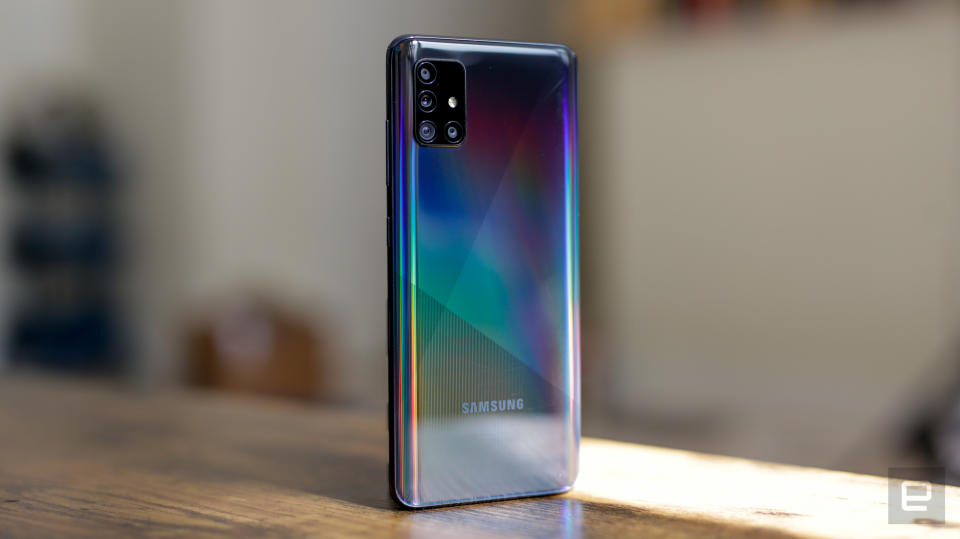
Flagship style
If there's one thing Samsung deserves credit for, it's that the A51 in no way looks like a $400 phone. With a surprisingly trim frame; an eye-catching, light-refracting finish; and some incredibly small bezels, this midrange model could easily pass for a phone that costs twice as much. As far as I'm concerned, this is the best-looking midrange smartphone out there. Just keep in mind that thanks to its display, the A51 might be a nonstarter for people with smaller hands — it's thin but still plenty large.
Of course, since this phone costs a fraction of what a flagship does, Samsung had to be judicious about balancing style and substance. Consider Samsung's choice of materials: Wrapping a phone in glass quickly makes its price tag jump, so the company used what it calls "Glasstic" for the A51's body. As the name suggests, that just means this phone has a plastic frame that sort of feels like glass if you don't scrutinize it too much. The Galaxy A51 also lacks an IP-rating for water and dust resistance, which is very common for phones in this price range. (Note: If you Google "A51 water resistance," you might see a search result from Verizon claiming the A51 is rated IP68 — it absolutely is not.)
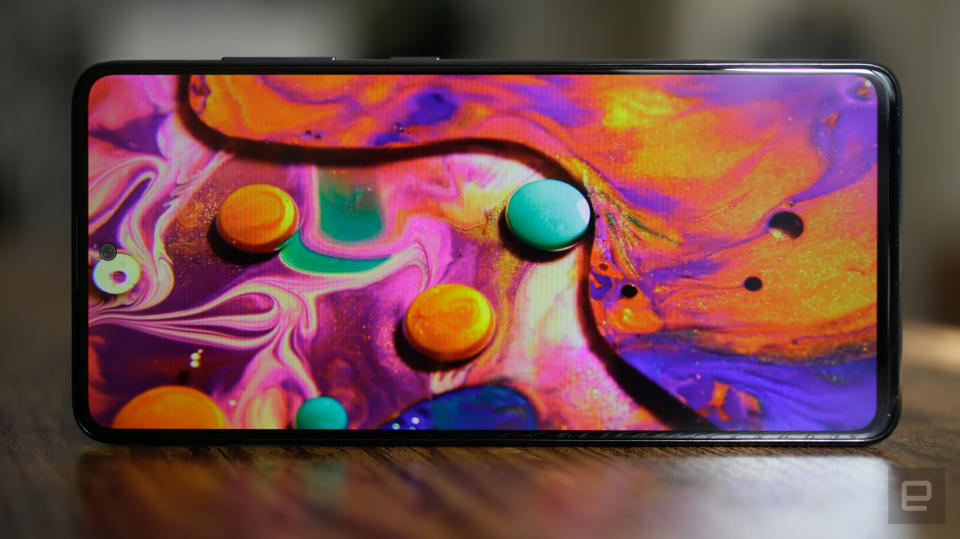
The rest of the phone's design is fairly standard. There's a USB-C port that supports 15W fast charging and a combination nanoSIM/microSD card tray on the phone's right side that you can use to augment the standard 128GB of storage. If you're a music fan, you'll also appreciate the proper headphone jack Samsung squeezed into the A51, since its single speaker is pretty awful.
What helps elevate the A51's design is its spacious, 6.5-inch, Full HD+ Super AMOLED screen. It's one of Samsung's Infinity-O displays which, if you're allergic to marketing BS, means there's a tiny hole cut out of the panel to accommodate a 32-megapixel front camera. It’s remarkably small and would be easy enough to overlook were it not for the shiny metallic ring surrounding it — it's almost like Samsung wants you to keep looking at it. Thankfully, the rest of the screen is typical Samsung: Deep blacks, punchy colors, and great viewing angles considering the price. Its max brightness feels a little anemic so outdoor use can be a little tricky at times, but the display is very well-suited to binging on YouTube videos while you're sheltering at home.
The screen is very often the most expensive component in a smartphone, and I'm glad that Samsung went with the display it did here. It's not just easy on the eyes; it’s a great rebuttal to devices like the iPhone SE that rely on dated designs to keep costs down. Visually, the A51 is a stunner, but as my parents always used to tell me, looks aren't everything.
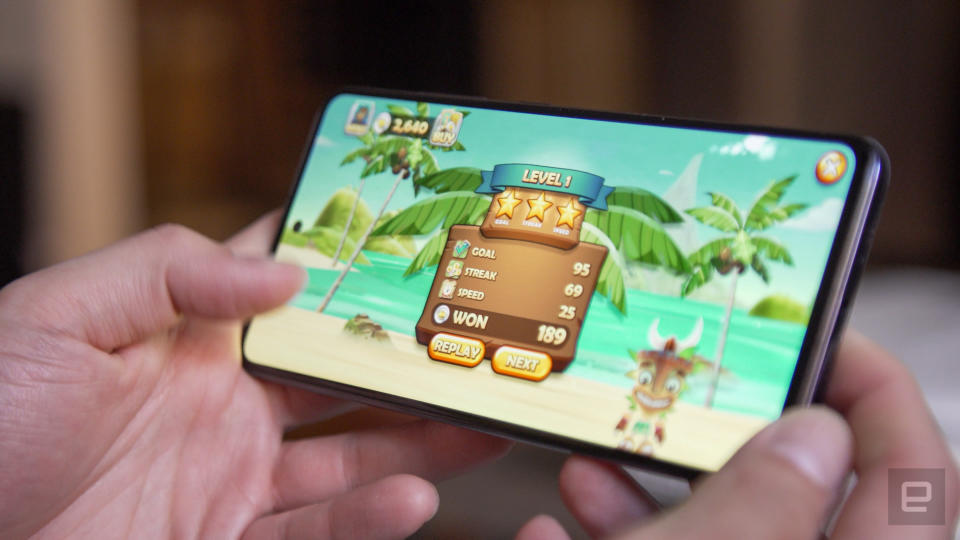
In use
The frustration here begins when you go to unlock the phone. There's an optical fingerprint sensor under the display, and it's... not great. When it does work, it usually takes a while to actually recognize my thumb. Too often, though, the sensor just didn't work. Normally, you'd see a bit of green whooshing around your finger to let you know the sensor was analyzing your print, but that didn't always appear. Repeated screen cleanings didn't fix the issue, and neither did re-enrolling my fingers. For your sanity, maybe just set up a PIN or an unlock pattern instead.
Once I made it in, a bigger issue became obvious pretty quickly — the A51 is noticeably laggy at times. Switching between apps frequently felt choppy, as did thumbing through pages of apps, and even just popping back out to the home screen. You know, the stuff you do every day.
To be clear, this doesn’t happen constantly, and I didn’t have much to complain about when the phone was firing on all cylinders. If you're the kind of person who just wants to watch videos and maybe send a few emails to the family, you might not even notice this momentary lag. But if you're a fan of smooth, consistent performance, be prepared for some disappointment — stuttering animations and delayed app launches are never too far away, and it gets old pretty quickly.
Exactly why the A51 runs the way it does isn't wholly clear, but part of the issue probably lies with Samsung's choice of chipset. Rather than use a Qualcomm Snapdragon like most US-bound Android phones, the company ran with its in-house Exynos 9611. From what I can tell, there's not much difference between this sliver of silicon and the Exynos 9610 Samsung started using in late 2018 — some of the CPU cores are marginally faster and it supports a wider variety of rear cameras, but that's really it. That Samsung would splurge on a great screen and use a minor refresh of a chip that was announced a little over two years ago tells you a lot about its priorities.
The funny thing is, this chipset is no slouch. It falls somewhere between the $250 Moto G Power (with a Snapdragon 665 chipset) and the $470 Pixel 3 XL (with a Snapdragon 670), which is exactly what you'd expect considering how much these phones cost. The A51 benchmarks pretty well, too — it’s nowhere near flagship level, but well in line with other US-bound devices we’ve seen in this price range. That being the case, it seems more likely that this inconsistent performance is due to a lack of software optimization that could theoretically be fixed in a future update. (For what it’s worth, Samsung wouldn’t confirm that any such updates were in the works.)
In fairness to Samsung, people contemplating a $400 smartphone probably know not to expect best-in-class performance. The bigger issue here is that it’s still a considerable sum to drop on a smartphone, and the A51's balance of performance and price just doesn’t feel right.
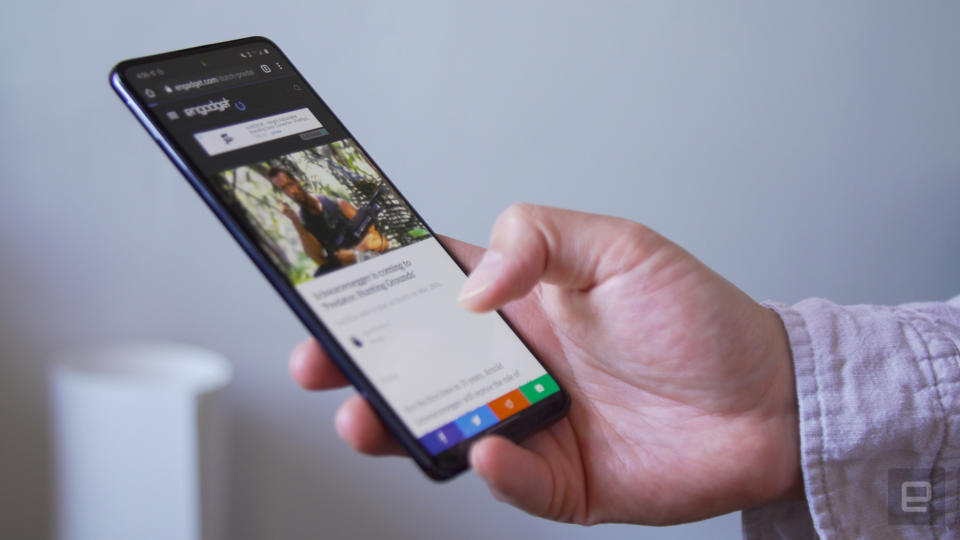
The Moto G Power — a phone that costs $150 less with an older chipset — manages to run a little more consistently. And the Pixel 3a XL? Forget about it. The difference in smoothness and the overall quality of experience between these devices skews heavily in the Pixel's favor. It’s also worth noting that all three of these phones have 4GB of RAM, so it’s not like Motorola or Google had more resources to work with here. And if you’re not married to Android, there's always the iPhone SE. It's a $400 arrow aimed at Samsung's heart and runs just as well as Apple’s most expensive smartphones. Whether it's because of a heavy touch with software, poor memory management, or something else entirely, this questionable performance makes the A51 hard to recommend for the price.
I had hoped that epic battery life would've sweetened the deal here, but it doesn’t. Despite packing a pretty sizable 4,000mAh (along with a mid-range chipset and a screen that only runs at 1080p), the Galaxy A51 is only good for about one full day of use. That's not awful by any stretch, but when other mid-range phones — like the Moto G Power — have battery lives measured in days instead of hours, the A51 can't help but feel a little disappointing.
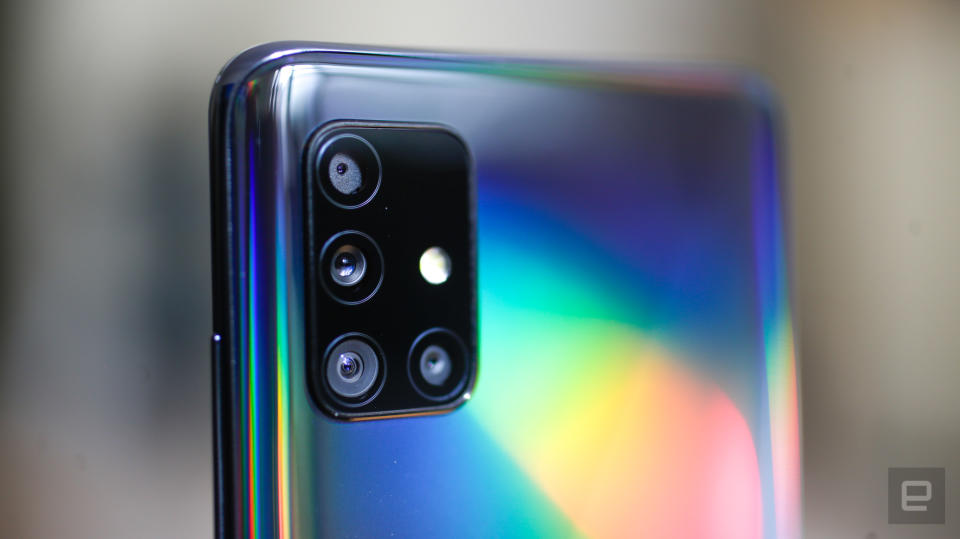
Plenty of cameras
At this point, the one thing that could redeem the A51 is truly excellent camera performance. Calling the phone's trio of rear cameras "excellent" would be a stretch, but in most cases, they're good enough.
And that's right, I said "trio" although there are four lenses on the A51's rear. Most of the time you'll wind up using the 48-megapixel standard wide camera which, like most other phones with pixel-rich sensors, produces smaller 12-megapixel stills by default. As usual for a Samsung phone, the results feature lots of vivid colors, though pixel-peepers will notice a surprising lack of fine details upon zooming in. That’s despite Samsung’s typical — and almost stylized — image processing, too. Big surprise, right? Like nearly every Samsung camera before it, this one seems tuned to deliver images that look slightly nicer than reality. These are great photos to post on Instagram, but maybe not for printing and mounting on your wall. Unfortunately, even the decently wide f/2.0 aperture doesn't help the A51's main camera much in low light — colors tend to look a little washed out, and details get smeared into oblivion.
Meanwhile, the 12-megapixel ultra-wide camera turned out to be a pleasant surprise. It captures a 123-degree field of view with minimal barrel distortion around the edges, and its colors are even poppier and more saturated than what you'd get out of the main camera. If you're walking around and shooting photos on a clear day, those pale blue skies will turn out a little more neon than you'd expect. Since this camera is mainly meant to capture lots of attractive, well-lit space, it's no surprise that it struggles more than the main camera does in low light.
Rather than a telephoto camera (which was almost certainly too expensive for a phone like this), the A51's third sensor is a 5-megapixel affair for macro photos. I've wondered in the past who spends their time bopping around and looking for very small things to take photos of, but ever since testing the OnePlus 8 Pro, I've become one of those people. It's too bad, then, that this never produced the sort of crisp, super-tight images I was hoping for. That's partially because the camera's image processing seems to iron out some of those minute details, but also because the narrow depth of field means getting everything framed up just right can take some work.
And that last lens? It's for a 5-megapixel depth sensor that Samsung uses to capture data for more bokeh-filled portraits. It does its job well. I've seen more than a few phones struggle with accurately separating the subject from its background, but the A51 handles the task without much fuss.
Ultimately, no matter which camera you spend the most time with, be prepared for good — not great — results. If getting the best overall photo is your biggest concern, you'd still be much better off with one of Google's Pixel 3As or the iPhone SE. Samsung's real edge here doesn't lay in the quality of its images so much as the flexibility that multiple cameras provide.
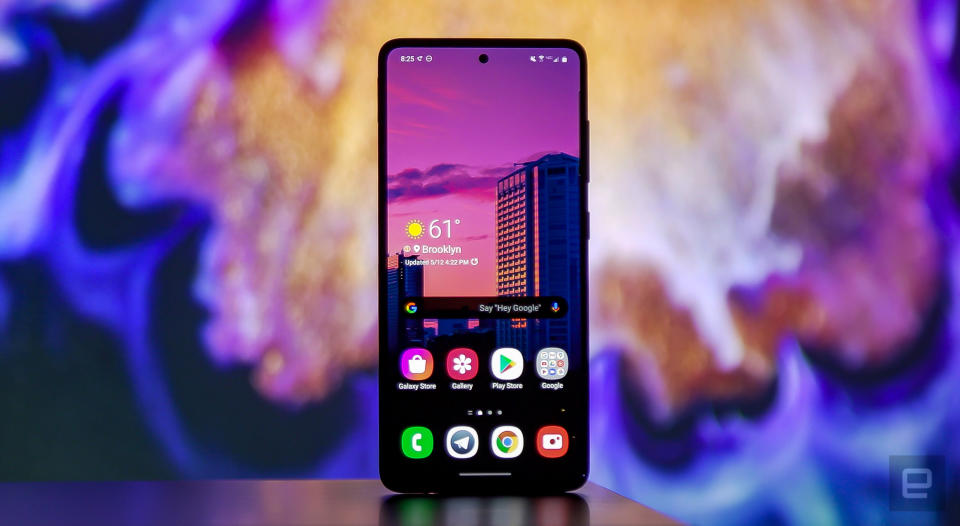
Wrap-up
With the Galaxy A51, Samsung tried to bring some flagship style and features to an affordable smartphone. It wasn't completely successful, but the effort is appreciated. More than anything, what Samsung really got wrong here (in the US, at least) is the phone's price. If the Galaxy A51 cost closer to $300, as it does in certain overseas markets, Samsung's strange blend of style and stymied performance would be a lot easier to swallow. As it stands, though, the A51 never feels as consistently smooth as some of the truly great devices you can get for around $400 now.
Sure, the Pixel 3a XL and the iPhone SE lack the A51’s panache, but they’re just nicer to use. And hey — if you’re really itching for a Samsung phone and have some latitude in your budget, the slightly more powerful Galaxy A71 might be a better choice. If you can find a sweet deal — or don't mind trading an older phone in — the Galaxy A51 isn't a bad option. Anyone who doesn't need a phone now though should wait until Google releases its new mid-range Pixel and decide.

